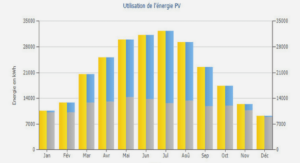LE MODÈLE SEMI-DISTRIBUÉ COMME OUTIL D’ANALYSE
Precipitation is the key factor controlling the high-frequency hydrological response in catchments, and streamflow simulation is thus dependent on the way rainfall is represented in the hydrological model. A characteristic that distinguishes distributed from lumped models is the ability to explicitly represent the spatial variability of precipitation. Although the literature on this topic is abundant, the results are contrasted and sometimes contradictory. This paper investigates the impact of spa- tial rainfall on runoff generation to better understand the conditions where higher-resolution rain- fall information improves streamflow simulations. In this study, we used the rainfall reanalysis de- veloped by Météo-France over the whole French territory at 1-kilometer and 1-hour resolution over a 10-year period. A hydrological model was applied in the lumped mode (a single spatial unit) and in the semi-distributed mode using three unit sizes of sub-catchments. The model was evaluated against observed streamflow data using split-sample tests on a large set of 181 French catchments representing a variety of size and climate conditions. The results were analyzed by catchment clas- ses and types of rainfall events based on the spatial variability of precipitation. The evaluation clearly showed different behaviors. The lumped model performed as well as the semi-distributed model in western France where catchments are under oceanic climate conditions with quite spatial- ly uniform precipitation fields. In contrast, higher resolution in precipitation inputs significantly im- proved the simulated streamflow dynamics and accuracy in southern France (Cévennes and Medi- terranean regions) for catchments in which precipitation fields were identified to be highly variable in space. In all regions, natural variability allows for contradictory examples to be found, showing that analyzing a large number of events over varied catchments is warranted.
A review of the hydrologic literature shows that there is no consensus on the impact of spatial reso- lution on the performance of hydrological models (e.g., Reed et al. 2004; Smith et al. 2012). There are several reasons for that. First, most previous studies have been limited to a single or a few catchments (Ajami et al., 2004; Bell and Moore, 2000; Das et al., 2008; Finnerty et al., 1997; Lindström et al., 1997; Reed et al., 2004; Smith et al., 2004; Smith et al., 2012; Winchell et al., 1998; Zhang et al., 2004), which makes conclusions highly dependent on the characteristics of the catch- ments studied. Interestingly, their contradictory conclusions show that the impact of the rainfall spatial distribution on runoff depends on catchment and event characteristics (Segond et al., 2007; Singh, 1997; Tetzlaff and Uhlenbrook, 2005; Viglione et al., 2010; Woods and Sivapalan, 1999; Zoccatelli et al., 2011). Second, many studies are virtual experiments based on synthetic flows, in which model simulations are compared to other simulations chosen as reference. This makes it dif- ficult to reach conclusions transposable to actual case studies (Andréassian et al., 2004; Das et al., 2008). Last, the parameterization strategies used may introduce a bias in the evaluation of model- ing approaches with different resolutions if parameters are not recalibrated or rescaled at each spatial resolution investigated (Kampf and Burges, 2007; Koren et al., 1999; Kumar et al., 2013; Morin et al., 2001; Samaniego et al., 2010).
That being said, the sensitivity of hydrological simulations to the spatial variability of precipitation inputs has been an active research area over the last three decades. There are at least two origins for this sensitivity: (i) the density of the precipitation measurement network, which more or less finely samples the actual precipitation field, and (ii) the inadequacy of the rainfall-runoff models’ structure and spatial discretization. This review will not examine the first point, which has already been widely studied. All authors agree that spatial rainfall measurement is important at all scales and that its importance increases as catchment size decreases (Beven and Hornberger 1982; Ogden and Julien 1993; Michaud and Sorooshian 1994; Obled et al. 1994; Faures et al. 1995; Shah et al. 1996; Winchell et al. 1998; Sun et al. 2000; Carpenter et al. 2001; Andréassian et al. 2001; Berne et al. 2004; Arnaud et al. 2011; Vaze et al. 2011; Emmanuel et al. 2012). Let us here focus on the relationship between spatial rainfall representation and runoff response. Results presented in the literature are contrasted and sometimes contradictory. Several studies concluded that including more detailed information on rainfall spatial distribution improves dis- charge simulation, whereas other studies have, surprisingly, shown the lack of significant improve- ment in simulations. A variety of studies have shown little (or no) impact of explicitly accounting for rainfall variability and several authors have suggested that a correct assessment of the rainfall input volume is more important than the rainfall spatial pattern itself (even in a highly spatially variable pattern) for simulating streamflow hydrographs.





